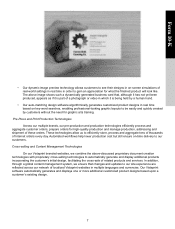Vistaprint 2014 Annual Report Download - page 21
Download and view the complete annual report
Please find page 21 of the 2014 Vistaprint annual report below. You can navigate through the pages in the report by either clicking on the pages listed below, or by using the keyword search tool below to find specific information within the annual report.
17
A significant portion of our revenues and expenses are transacted in currencies other than the U.S. dollar,
our reporting currency. We therefore have currency exchange risk, despite our efforts to mitigate such risk
through our currency hedging program.
We are exposed to fluctuations in currency exchange rates that may impact items such as the translation of
our revenues and expenses, remeasurement of our intercompany balances, and the value of our cash and cash
equivalents and other assets and liabilities denominated in currencies other than the U.S. dollar. For example, when
currency exchange movements are unfavorable to our business, the U.S. dollar equivalent values of our revenue
and operating results and net assets recorded in other currencies is diminished, particularly in certain currencies
where we have disproportionate revenues or expenses. While we engage in hedging activities to try to partially
mitigate the impact of currency exchange rate fluctuations, our results of operations and financial condition may
differ materially from expectations as a result of such fluctuations. As we expand our operations throughout the
world, our exposure to additional currencies and exchange rate fluctuations is increasing. Additionally, our income
tax rate may be impacted by fluctuations in currency exchange rates in jurisdictions where our tax returns are
prepared in a currency other than the functional currency.
Our hedging activity could negatively impact our results of operations and cash flows.
We have entered into interest rate swap and currency forward contracts to manage differences in the
amount of our known or expected cash payments or receipts related to our long-term debt and operating cash
flows. Our objective in using these derivatives is to manage our exposure to interest rate and currency movements.
If we do not accurately forecast our future long-term debt, revenue or expenditure levels, execute contracts that do
not effectively mitigate our economic exposure to variable interest and currency rates, elect to not apply hedge
accounting, or fail to comply with the complex accounting requirements for hedging, our results of operations and
cash flows could be volatile, as well as negatively impacted.
We face risks related to interruption of our operations and lack of redundancy.
Our production facilities, websites, infrastructure, supply chain, customer service centers, and operations
may be vulnerable to interruptions, and we do not have redundancies in all cases to carry on these operations in
the event of an interruption. Some of the events that could cause interruptions in our operations or systems are,
among others:
• fire, flood, earthquake, hurricane, or other natural disaster or extreme weather;
• labor strike, work stoppage, or other issue with our workforce;
• political instability or acts of terrorism or war;
• power loss or telecommunication failure;
• attacks on our external websites or internal network by hackers or other malicious parties;
• undetected errors or design faults in our technology, infrastructure, and processes that may cause our
websites to fail;
• inadequate capacity in our systems and infrastructure to cope with periods of high volume and demand;
and
• human error, including poor managerial judgment or oversight.
In particular, both Bermuda, where substantially all of the computer hardware necessary to operate our
websites is located in a single facility, and Jamaica, our largest customer service, sales, and design support
operation, are subject to a high degree of hurricane risk and extreme weather conditions.
We have not identified alternatives to all of our facilities, systems, supply chains, production operations, and
infrastructure to serve us in the event of an interruption, and if we were to find alternatives, they may not be able to
meet our requirements on commercially acceptable terms or at all. In addition, because we are dependent in part
on third parties for the implementation and maintenance of certain aspects of our communications and production
Form 10-K
























